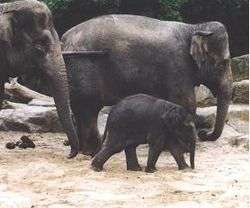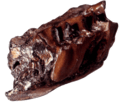List of extinct animals of the Philippines
The Philippines had a large and diverse group of mammalian species in the past. They are widely distributed across the archipelago. However, they became extinct due to several factors.There are at least eight mammalian species that have been extinct since the Pleistocene Epoch. A fossil species of Sirenia has been found in Palawan and was found out to be extinct since the Miocene. But, there are also extinct deer and pig fossil remains known in the Philippines that are not yet included in this list, as well as other buffalo and small mammal species from the Pleistocene Epoch. The Asian elephant, a species that became extinct in the 13th to 16th(?) century, was originally transported to the Sultanate of Sulu and Maguindanao but became extinct on those areas or were transported back to Sabah for unknown reasons. One former species, Acerodon lucifer is now extinct, but is now highly regarded as part of the species Acerodon jubatus today, thus, the species still thrives in the archipelago, but is locally extinct on the island of Panay.
Archaeological findings yielded information regarding the extinct Mammalian species found in the Philippines through the excavation of various sites in the country. Below is a table of those species.
This is a list of extinct mammalian species found in the Philippines.
| Common name | Picture | Order | Family | Genus | Species | Description |
|---|---|---|---|---|---|---|
| Elephant species |
|
Proboscidea | Elephantidae | Elephas | Elephas sp. | Prehistoric: Found in Iloilo, Panay Island |
| Asian elephant |
|
Proboscidea | Elephantidae | Elephas | Elephas maximus | Introduced in the 13th-16th? century from Sabah in the reign of the Sultanate of Sulu, and became extinct on Maguindanao or were transported back to Sabah. Bone fragments were the only proof left behind. |
| Stegodon |
|
Proboscidea | Stegodontidae | Stegodon | Stegodonluzonensis Stegodonmindanensis | Once roamed in the plains of Luzon, Mindanao and entire Philippine Archipelago. Unfavorable geographical conditions and human intervention caused their extinction.[1] |
| Palawan fossil Sirenia |
|
Sirenia | Dugongidae | Dugong | Dugong sp.? | Lived during the Miocene.
Discovered in Palawan in 2011. The fossil hasn't yet been extracted from the rocks in fear of destroying the natural heritage caves of Palawan. Future technology in fossil extraction is the only way to get and identify the fossil.[2] |
| Fossil batomys |
|
Rodentia | Muridae | Batomys | Batomys sp. | Lived during the Pleistocene. Excavations in Callao Cave, in the lowland (c. 85 m elevation) Cagayan River Valley of northeastern Luzon, Philippines, have produced the first fossils of any endemic genera of Philippine murid rodents. Three dentaries dated to the Late Pleistocene, between c. 50,000 and 68,000 BP, are referred to the genera Batomys and Apomys.[3] |
| Tiger |
|
Carnivora | Felidae (Subfamily: Pantheridae) | Panthera | Pantheratigris | Extinct in Philippines in Palawan Island (Holocene to Pleistocene) Note: The subspecies of the tiger bones found in Palawan is unsure, though it is closer to the Sumatran tiger. They became extinct n Palawan when a small group of them became trapped when the gap widened as a result of sea levels. They became extinct due to a combination of diminished prey, loss of habitat and possibly overhunting.[1][4] |
| Philippine rhinoceros |
|
Perissodactyla | Rhinocerotidae | Rhinoceros | Rhinoceros philippinensis | Due to the lack of a complete skeleton, little is known about Rhinoceros philippinensis, other than that it lived during the Pleistocene era (2.588 million – 11,700 years ago) and that it was essentially the larger version of its modern cousin, the Sumatran rhino.
Fossilized upper jaw. The specimen is a portion of right upper jaw with two well-preserved molars and a broken one of a rhinoceros.[1][5] |
| Cebu warty pig |
|
Artiodactyla | Suidae (Subfamily: Suinae) | Sus | Suscebifronscebifrons | The Cebu warty pig previously lived in Cebu, Philippines before becoming extinct in modern times, primarily due to habitat destruction. This pig was assessed to be extinct in 2000. |
| Palawan Cervus | Artiodactyla | Cervidae (Subfamily: Cervinae) | Cervus | Cervus sp. | Extinct since Pleistocene, found in Mainland Palawan | |
| Cebu dwarf buffalo |
|
Artiodactyla | Bovidae (Subclass: Bovinae) | Bubalus | Bubalus cebuensis | Lived during the Pleistocene. The Cebu tamaraw (Bubalus cebuensis) is a fossil dwarf buffalo discovered in the Philippines, and first described in 2006. B. cebuensis would have stood only 75 cm (about 2 ft 6 in) and weighed about 150 to 160 kg (around 300 lbs).[1][6][7] |
See also
References
- 1 2 3 4 Mark V. 7 Prehistoric Animals You Didn’t Know Once Roamed The Philippines, retrieved from: http://www.filipiknow.net/prehistoric-animals-in-the-philippines/
- ↑ Tann (2011), 20-million-year-old fossil sea cow discovered in Palawan, retrieved from: http://archaeologynewsnetwork.blogspot.com/2011/10/20-million-year-old-fossil-sea-cow.html
- ↑ Heaney, et al (2007), The first fossil record of endemic murid rodents from the Philippines: A late Pleistocene cave fauna from northern Luzon retrieved from: http://www.bioone.org/doi/abs/10.2988/10-32.1
- ↑ Piper, P., Ochoa, J., Lewis, H., Paz, V., &Ronquillo, W. (2008). The first evidence for the past presence of the tiger Pantheratigris (L.) on the island of Palawan, Philippines: Extinction in an island population Palaeogeography, Palaeoclimatology, Palaeoecology, 264 (1-2), 123-127
- ↑ http://philmuseum.ueuo.com/nm_museum/nmtreasure/geo/rhino.html
- ↑ American Museum of Natural History (2006) Fossil Of New Species Of Dwarf Buffalo From Philippines, retrieved from: http://www.amnh.org/our-research/science-news2/2006/fossil-of-new-species-of-dwarf-buffalo-from-philippines-described-by-american-museum-of-natural-history-paleontologist-and-colleagues
- ↑ Loren Coleman, (2006), Fossil Dwarf Buffalo Discovered, retrieved from: http://cryptomundo.com/cryptozoo-news/dwarf-buffalo/










